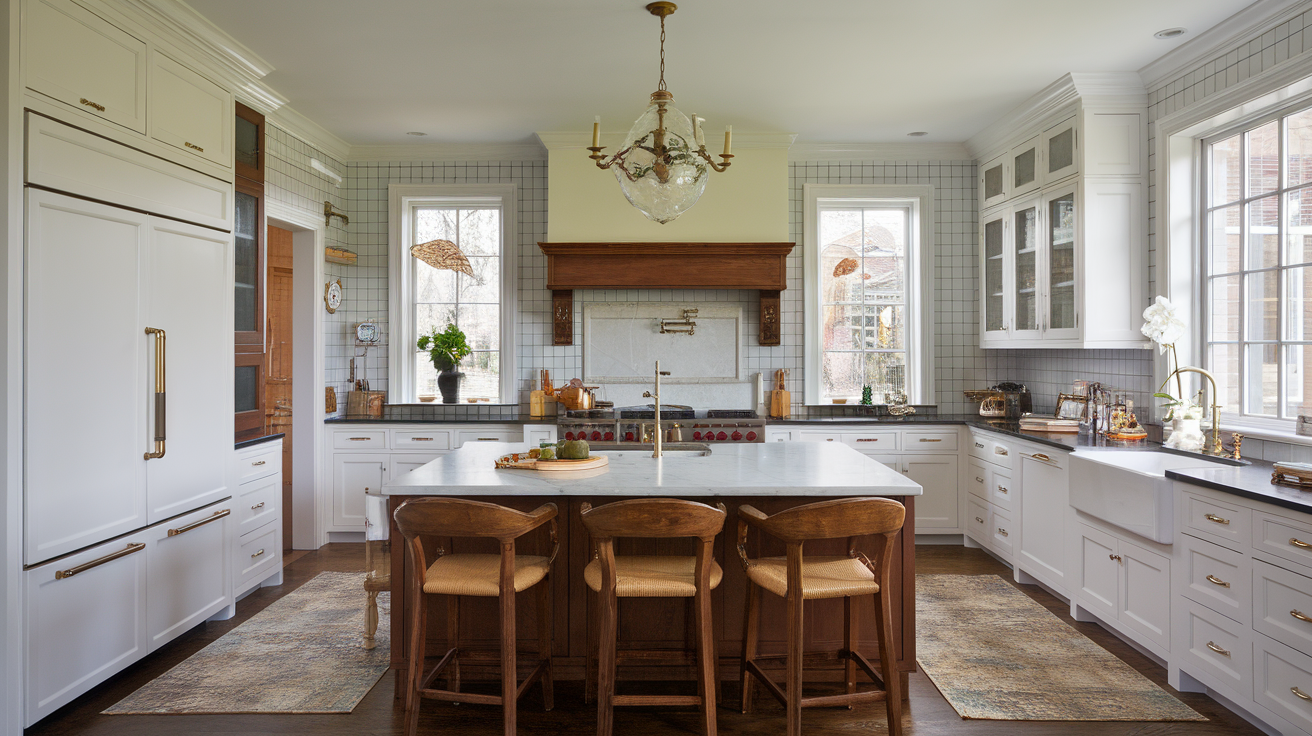If you’ve ever wished your kitchen whispered stories from the past while still being a functional space for the present, welcome to the charm of 1910 kitchen style.
Picture a world where utility met charm, where beadboard walls and cast-iron stoves weren’t just design features—they were everyday essentials. This era wasn’t flashy. It was practical, durable, and surprisingly beautiful in its understated way.
1. Incorporate Beadboard Walls for Instant Vintage Warmth
If walls could talk, beadboard would speak in soft, nostalgic tones. In the 1910s, beadboard—those narrow vertical wooden planks—was a staple for kitchens. It added texture, warmth, and a clean, orderly feel. Bring it into your home by installing it as wainscoting, backsplash, or even full-height walls. Go for white or creamy paint to keep things light and era-authentic.
2. Wooden Kitchen Cabinets with Natural Finishes
Cabinets back then weren’t sleek or glossy—they were built to last, often made from oak or pine, with visible grain and honest craftsmanship. Recreate this by avoiding overly modern finishes. Look for or refinish cabinets in a natural or lightly stained wood, and consider inset doors rather than overlay styles.
3. Farmhouse Sinks with Aprons
One defining feature of a 1910s kitchen is the deep, white farmhouse sink, typically made of fireclay or cast iron with a porcelain finish. These sinks weren’t just pretty—they were practical for washing big pots and pans. To recreate the look, choose a sink with a classic apron front and pair it with a bridge faucet for extra vintage flair.
4. Painted Wooden Floors in Muted Tones
Hardwood floors were common, but often painted to hide wear or match a home’s trim. Soft gray, green, or cream-colored painted floors give off that authentic 1910s spirit. If you’ve got original wood floors, consider restoring and painting them—or choose wide plank engineered wood and paint over that for an antique look.
5. Glass-Front Cabinets for Showcasing Dishware
In a world before open shelving was trendy, glass-front cabinets allowed homeowners to show off their good china while keeping everything tidy. Choose leaded or simple clear glass panels with inset cabinetry for an authentic look. Bonus: it forces you to keep things organized—just like great-grandma did.
6. Freestanding Furniture Pieces
The 1910 kitchen didn’t rely entirely on built-in cabinetry. Many homes had freestanding hutches, pie safes, or tables that served both storage and prep purposes. Scout out vintage pieces from antique stores or flea markets. A distressed green or cream hutch with original hardware? Instant time portal.
7. Muted, Earthy Color Palette
Forget neon and gloss. The 1910 color palette leaned heavily on earthy, muted tones: soft sage, dusty rose, buttercream, taupe, or robin’s egg blue. These colors were often created using milk paint or early latex versions and aged beautifully. Use this palette for cabinetry, walls, and trim to remain historically respectful while still inviting.
8. Ceiling-Mounted Drying Racks
Before electric dryers, families relied on wooden drying racks suspended from ceilings. While more common in laundry rooms, these found their way into kitchens in smaller homes. Installing one above a worktable or island adds vintage form and function—perfect for drying herbs or dish towels.
9. Reproduction or Antique Iceboxes
Before refrigeration became common, the icebox reigned supreme. These wooden boxes with metal interiors and hardware for ice blocks are now coveted antiques. If you can find one, restore it as a conversation-starting storage piece. Or opt for a modern fridge with a paneled front that mimics an old-fashioned look.
10. Wall-Mounted Sinks and Simple Fixtures
In more modest kitchens, wall-mounted porcelain sinks were standard. They saved space and made cleaning easier. Pair one with cross-handle faucets and exposed plumbing. These small details go a long way in preserving the authenticity of a period-style kitchen.
11. Tin Ceiling Tiles for a Dramatic Throwback
A staple of the time, tin ceilings added visual interest and were also fire-resistant. They came in ornate patterns and were often painted white or metallic. Use reproduction tin tiles on your ceiling, or even as a backsplash, for that vintage wow-factor.
12. Oilcloth Tablecloths and Curtains
For a truly lived-in feel, embrace textiles. Oilcloth tablecloths with floral patterns or gingham curtains in red or green evoke the era’s practicality and cheer. Choose patterns that feel vintage without looking overly “theme-y.”
13. Cup Hooks and Wall Storage
Cabinets were fewer, and wall space was maximized. Install simple hooks or rails with S-hooks to hang your utensils, pans, and towels. This utilitarian storage method adds charm and functionality, reminiscent of kitchens where every inch was used wisely.
14. A Real Work Table or Butcher Block Island
The heart of a 1910 kitchen was often a central worktable, sometimes used for kneading dough, prepping vegetables, or holding a meat grinder. Instead of a modern kitchen island, go for a sturdy wood table or butcher block surface with visible wear and history. This adds soul you just can’t fake.
15. Built-In Bread Drawers and Bins
Pantries weren’t always walk-in. Instead, clever built-ins made the most of cabinetry. Wooden flour bins, bread drawers, and slide-out cutting boards were genius space-savers and deserve a comeback. Consider adding these elements to your cabinetry for both charm and utility.
16. Early 20th Century Light Fixtures
Electricity was becoming common, but fixtures remained simple. Look for schoolhouse pendants, milk glass shades, or brass sconces to echo the lighting of the time. Bonus points for a mix of ambient and task lighting—something those early homemakers would have appreciated.
17. Tile Backsplashes with Subway Tiles
While not widespread, white subway tile began appearing in kitchens during the 1910s. It was easy to clean and gave a crisp look. Today, it’s a classic that never feels out of place. Go with white grout for a subtle look, or darker grout for a more modern, contrast-rich twist on a historical style.
18. Wall Clocks with Roman Numerals
Before smartphones told us the time, oversized kitchen clocks kept everything on schedule. Look for reproduction wall clocks with Roman numerals, metal frames, or distressed wood faces for that lived-in, timeless touch.
19. Modest Hardware with Character
Cabinet knobs and drawer pulls were often ceramic, glass, or simple cast iron. Think classic white porcelain knobs, bin pulls, or even turn latches. Swapping modern hardware for these humble designs can instantly age your kitchen—in the best way possible.
20. Baskets, Crates, and Crocks for Storage
Pantry storage didn’t include plastic bins or stackable Tupperware. Think wicker baskets, vintage crates, and ceramic crocks. Use them to store potatoes, onions, utensils, or linens. Not only are they useful—they also lend a well-worn, unfussy authenticity.
21. Classic Stoves as Focal Points
If you can snag a restored cast iron range or enamel stove, congratulations—you’ve struck vintage gold. These stoves, often with built-in warming shelves and hefty doors, serve as incredible centerpieces. Can’t find one? Consider retro-inspired modern appliances that mimic the look while offering today’s convenience.
22. Old-School Linoleum or Checkerboard Flooring
While hardwood was common, many 1910 kitchens also had linoleum floors in checkerboard or speckled patterns. Recreate this with modern vinyl or linoleum in black-and-white or muted two-tone palettes. It grounds your space in the past while staying durable.
23. Open Shelving with Scalloped Edges
Some 1910 kitchens featured open shelves with decorative scalloped trim. Install a few open shelves painted to match your cabinetry and use them for dishware, cookbooks, or vintage canisters. Add scalloped trim underneath for a sweet, period-correct detail.
24. Enamelware and Mason Jars
Kitchen tools and containers were built to last. White enamelware with colored rims and mason jars with zinc lids were everywhere. Use them for storage, decor, or actual cooking tools. Their blend of form and function makes them perfect even today.
25. No-Frills Utility and Honesty in Materials
One core principle of the 1910 kitchen: form follows function. Every item had a job, and design followed practicality. Embrace this in your space by avoiding over-decoration. Let raw wood, exposed hinges, and honest wear show. It’s not just vintage—it’s sincere.
26. An Old-Fashioned Pantry or Larder Space
Even a small walk-in pantry can feel like it belongs to another time. Use open wooden shelves, vintage labels, baskets, and simple glass containers. Add a screen door or beadboard wall to enclose it and channel the spirit of the early 20th century.
27. A Sense of Story and Soul
Perhaps the most important idea of all: let your kitchen tell a story. Don’t chase a Pinterest-perfect museum. Instead, let it feel lived in—like it’s held generations of meals, laughter, and lessons.
Whether it’s a scratched worktable from your grandmother’s home or a chipped enamel pot from a flea market, choose pieces with patina and memory.
Conclusion
Creating a 1910-inspired kitchen isn’t about rigid rules or turning your home into a historical exhibit. It’s about capturing the spirit of an era that valued quality, simplicity, and quiet beauty. It’s about choosing materials that age with grace and honoring craftsmanship over trends.
So take your time. Let your kitchen evolve. Add a piece here, restore something there. Like a slow-cooked stew, a truly timeless kitchen can’t be rushed. But once it’s ready, oh, it nourishes everything around it—body, mind, and memory.


Leave a Reply